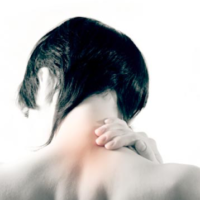
Virtually everyone wants to Reduce Upper Back and Neck Pain! It is understandable that we focus on locations that are painful.
These areas are all strained by head forward posture and rounding of the shoulders. It is useful to provide relief for these areas, both in treatment and with at-home self care.
- Back of the neck
- Upper back and area in between the shoulder blades
- Upper traps and shoulders
We may apply heat, gentle self-compression, and work to stretch these muscles, which are typically too engaged and are shortened from taut bands and myofascial trigger points.
However, lasting relief comes from correcting the underlying postural issues. In many cases, we can understand this pain, at least in part, as a symptom of Upper Crossed Syndrome.
Causes of Upper and Neck Pain
The Czech rehabilitation specialist Dr. Vladimir Janda coined the term Upper Crossed Syndrome (UCS) for a common series of degenerative changes that happen in the upper body.
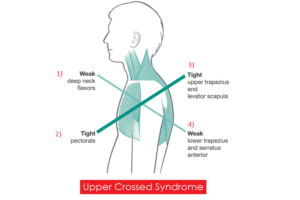
This collection of symptoms has become extremely common.
The normal balance of muscles between the front and rear of your shoulder girdle is disrupted.
Muscles in the chest and upper back are either shortened or pulled too tight.
Muscles in the neck and mid-back are either inactive or not strong enough.
This destabilizes the entire complex of your neck, shoulder and upper back
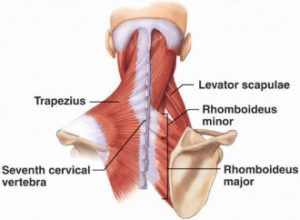 We all have tight muscles. Because we stretched muscle fibers uncomfortably, we experience tightness. However, this can happen in two different ways.
We all have tight muscles. Because we stretched muscle fibers uncomfortably, we experience tightness. However, this can happen in two different ways.
First, if we engage a muscle and hold it tightly, we have made it tight by shortening it. We might even do this unconsciously.
For instance, that is what happens to our upper traps as we hunch our shoulders. When we do that habitually, the muscles become ‘locked short.’
However, our rhomboids and middle traps, in between our shoulder blades, are a different matter.
These muscles get stretched by the rounding forward of our shoulder blades. They feel tight because we pull them uncomfortably long. When we do that habitually, the muscles become ‘locked long.’ It might be that it is this ‘locked’ aspect of these muscles that makes them feel tight.
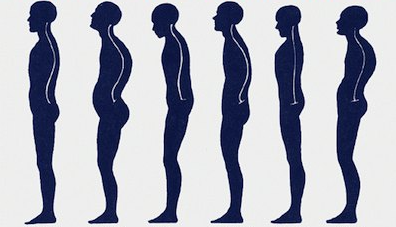
Posture is the way that we hold our ourselves as stand, sit, move and and sleep. However, we often use this word to refer to static, standing spinal posture.
Most of us can “assume the position” of relatively correct posture. We try to do this throughout the day, but we do it incorrectly. We have a natural tendency to try to keep our Center Of Mass (COM) over our our Base Of Support (BOS).
In these examples, postural changes were initiated by a more basic challenge to the COG such as rounded shoulders, tight spinal erectors or weak abdominal muscles or glutes.
Our instinct to align our BOS with our COG of gravity feels good – at first. However, over time, it becomes a maladaption that causes a cascade of chronic pain and limited range of motion.
Treatment Approach
So how do we fix it? In our experience working on the other three components of Upper Crossed Syndrome first is helpful:
First. move your head back over the spine by strengthening the deep cervical flexors in the front of the neck. This reduces strain on the back of your neck.
Next, open the connective tissue and muscles of the chest wall with targeted compression and stretches of the pec minor, intercostals and abdominal muscles. This reduces strain between your shoulder blades
Finally, strengthen the depressors of the shoulder – the lower traps and serratus anterior. This reduces strain on your upper traps and shoulders
Self compression of trigger points in the upper traps and levator scapula is good preparation to gentle stretching of these muscles.
It is a simple method and it works. We continue to use and improve this approach to treating upper back, neck and shoulder pain with great success.
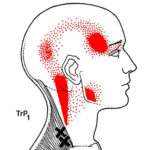
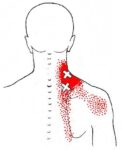 In general, we prepare our muscles for stretching and strength training with self-compression. For instance, using a Backknobber on trigger points in our upper traps and levator scapula can help release these tight muscles.
In general, we prepare our muscles for stretching and strength training with self-compression. For instance, using a Backknobber on trigger points in our upper traps and levator scapula can help release these tight muscles.
On the other hand, our rhomboids and middle traps are locked long. Compressing these muscles vigorously is counterproductive.
However, gently stimulating these muscles activates them so that they engage more normally.
Once the restrictions in our chest have eased, our rhomboids and middle traps have more freedom of movement and begin to work again.
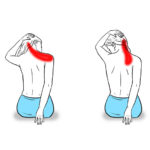 Typically, we don’t want to stretch the middle traps and rhomboids. They are chronically over-stretched anyway. Instead, we focus on stretching the upper trapezius and levator scapula muscles.
Typically, we don’t want to stretch the middle traps and rhomboids. They are chronically over-stretched anyway. Instead, we focus on stretching the upper trapezius and levator scapula muscles.
First, we stabilize the arm and shoulder of the side we stretching. Consider grasping the seat your are sitting on with your fixed arm. G
To stretch the upper trap, we grasp the side of the seat and gently flex our neck to the opposite side.
To stretch our levator scapula, we stabilize the arm from the back of the seat and gently rotate our neck to the opposite side.
